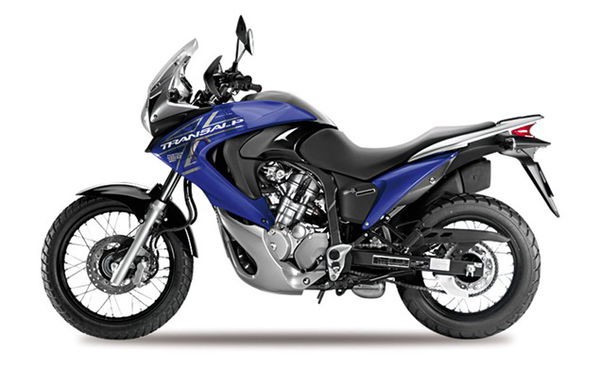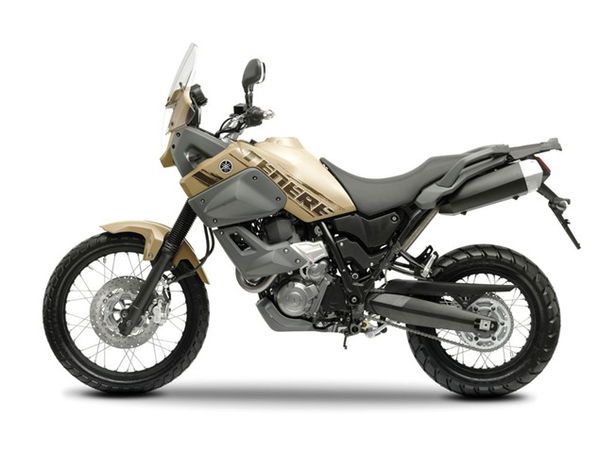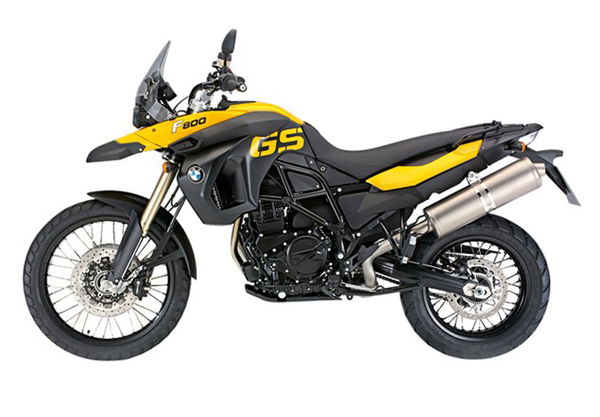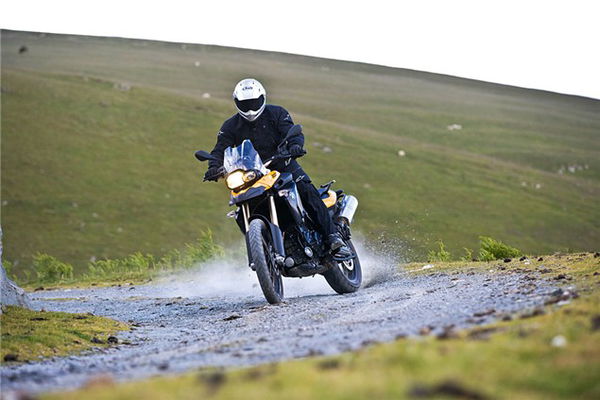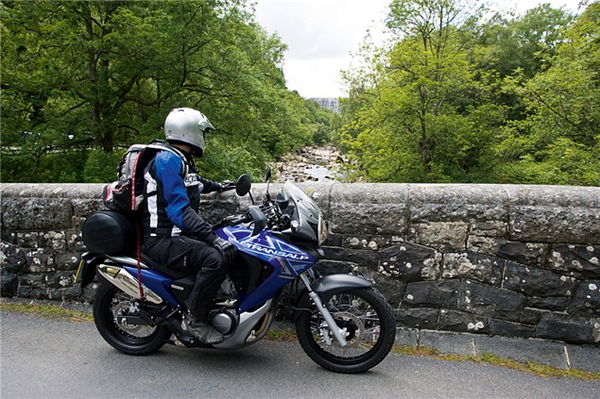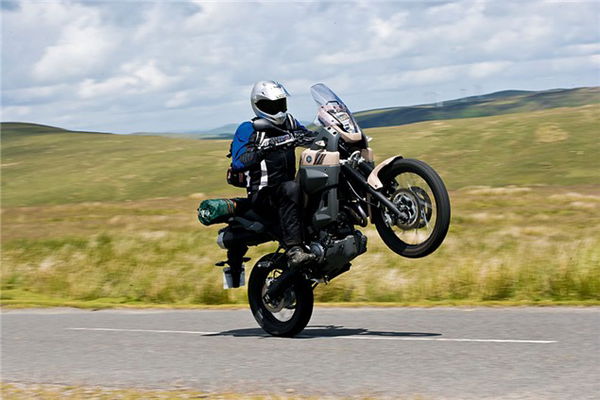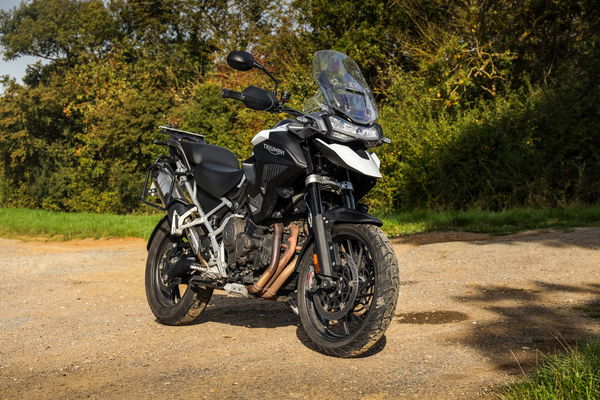Short Way Round - adventure bikes test
If you want a bike to have fun on, to commute on, to explore and maybe even have an adventure on, then you really need one of these.

height=10> | |
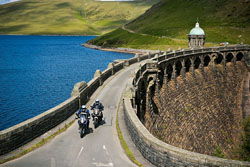 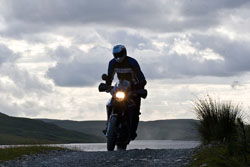 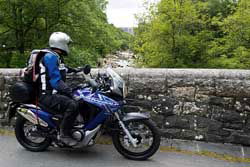 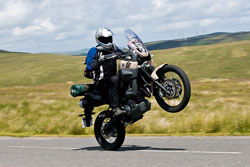  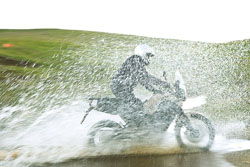 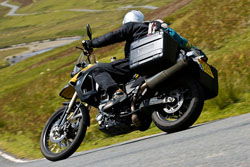 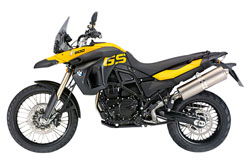 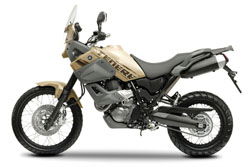 Everybody is talking about rocketing sales in the UK Adventure motorcycle sector. It’s true that some are styling exercises and incapable of traversing more than a series of puddles, but most are extremely practical and some even more fun than the sports bikes that they are hammering in the sales charts. A giant Adventure bike is cheaper to buy, insure and maintain than a sports bike, and is less likely to go missing or lose you your licence. If you only ride at weekends on short-term, road-biased adrenaline blasts then nothing is going to prise the sportsbike from your cold, dead hands, but for those looking for something more from their riding, it’s hard to ignore adventure bikes. All has not been perfect in Adventure Land, however. In the past several models have been aimed at bigger, more experienced riders - a BMW R1200GS Adventure with all the bells and whistles on is an intimidating tool for any rider, let alone a beginner. Indeed, there’s not been much in the way of introductory or middleweight contenders to add balance to the influx of global crusaders hitting the showroom floors. Until now. 2008 has seen the launch of three significant models, all of which have ancestry, pedigree, or both. From gentle green-laners to the full Ranulph Fiennes, the F800, Transalp and Tenere can take you places you never even knew you wanted to go. Yamaha and Honda have given us fresh-faced upgrades of models that have been kicking around for 20 years while BMW have built a smaller, more manageable version of their legendary off-roader but with an all-new engine and – horrors! – a drive-chain instead of a shaft. The new XT660Z Tenere has an enviable history of desert racing, fantastic styling and a mouth-watering price tag, while the XL700V Transalp has already secured its place as the unbreakable Steady Eddie of the mid-size ramblers. BMW have transplanted the power-plant from the unloved F800 road bike into a very interesting package that has the potential to open up the market. The Welsh assembly forms in an M4 service station and I’m already eyeing the Transalp with suspicion as it stands out like a camp tart next to these macho off-roaders. I can’t quite figure out why they settled on the quirky styling that is neither one thing nor the other, though undeniably unattractive. Parked next to the Tenere, I also can’t decide whether the Honda looks too short or the Yamaha too tall until I swing a leg over it and realise that the seat is actually very low to the ground, which is no bad thing considering the lack of choice for ladies and lower gentlemen. With the smallest of engine capacity increases (up 30cc to 680) the Honda sounds and feels very similar to its predecessor as it happily chugs onto the motorway and settles into a steady trot. Being sub six-foot is fine but anyone straying above that benchmark will feel and look a bit daft as they begin to dwarf the poor thing. Dimensions and styling aside, this is a Honda so everything is going to be just fine, because it always is. At a steady 80mph, the V-twin is quiet and smooth at just over 5,000rpm and extremely comfortable. I’d be genuinely happy, if unexcited, to spend day after day in this soothing saddle behind the surprisingly effective screen. In contrast, the XT stands tall and proud, and as skinny as a supermodel with a very purposeful, funky appearance. I like its angles and desert Khaki colour scheme and bet that this is a proper off-road tool. As I swing a leg over it at the first changeover I smash my shin against the passenger grab-rail and climb aboard. Thanks. It dawns on me that it looks tall because it is, and even my lengthier travel companions struggle to mount the beast. Unless I’m mistaken, Yamaha have dropped a slight clanger with the 895mm seat height (it actually feels even higher than that) and we haven’t so much as fired it up yet. I’m short but not short on confidence so it won’t bother me in the slightest, but I pity the poor punters who visit their local Yamaha dealers only to find that they’re struggling to climb aboard. To confirm my theory, I thumb the modestly powered single into life and shift through the gears to the 80mph/5,000rpm region and settle into a groove. After a short while, I take both feet off the pegs and attempt to scrape the toes of my boots on the tarmac and fail to make any contact. Other than potential traffic light howlers, another disadvantage of being so high up is that you’re more exposed to the elements and subject to a steady blast of air that travels up via the forks and yokes into the face. After the Honda, the seat feels firmer and the motor, being a single, is understandably less smooth, but we’re admittedly cruising at a speed that is slightly above the ideal for the Yam. I’m not worried as the XT looks like it will turn the tables once the we’re finished with the monotony of the M4. I already had a quick cross-country blast on the GS a few weeks ago and am pleased to report that sitting on it feels extremely normal, without a hint of controversy. The bug-eyed and beaky front end is very appealing yet the overall look is more approachable and usable than its bigger brother. Start up the parallel twin and a more satisfying engine note than you’d expect is emitted, but give the throttle a blip and the bark from the back end is near musical. It’s one of those bikes that will have even the most considerate motorcyclist blipping its tits off at every opportunity. Having a 25bhp advantage over the Honda and weighing 30kgs less, the GS hits the cruising pace effortlessly and settles at much the same revs as the others. Overtaking at higher speeds is easier too and despite it being the only 6-speeder here, it is also the least likely to need a down-change in order to make a pass as the motor has far stronger midrange than expected. But BMW have made a rather stingy allowance for fuel with a tank capacity of only 16litres – not ideal for a bike that has a sweet engine that loves to be revved. Secondly, as if to confirm that you won’t be travelling too far between stops, the seat is just not comfortable. It’s a little narrow but basically too hard – a mistake KTM made with their original 950 Adventure. Perhaps the Germans are merely stressing the off-road bias for this intro model and are making us wait for their beefed-up Adventure version before we can truly consider global touring. We’ve established that the Transalp is in a league of its own in terms of high-speed cruising and comfort, but is that all it has to offer? With the Bristol Channel behind us, and excellent tarmac ahead of our campsite destination in Rhayader, the low-slung Honda has the chance to keep its nose ahead of the rest. It’s fair to say that what the Transalp lacks in excitement, it replaces with sheer unstoppabilty. The SOHC V-twin is allowed 60bhp to haul 238kg plus rider so progress is always going to be sluggish, but the new, smaller 19” front wheel does combine nicely with the low centre of gravity to create fairly impressive turn-in and cornering ability. Pick up the pace and it won’t get upset, but you’ll need to keep the motor spinning between 6,000rpm and the 8,000rpm redline to maintain decent progress. The peppy Tenere makes surprisingly light work of the twisty A-roads despite being at a power and weight disadvantage. Its exceptional fuel capacity of 22 litres does have a bearing on the handling as that’s a lot of kilos sitting up high, but it also has a very positive bearing on its range – I noticed at our first fuel stop after 140 miles (the GS was very low) that the XT’s gauge showed that it had half a tank left. That’s what I call a useful touring range. Other than having a top-heavy feel with a full tank, it means that the Yam will tip the scales at over 200kg after a re-fuel, so the sub fifty-brake engine does a good job of propelling the thing forward and keeping up with the Transalp. You have to work it hard, don’t ask it to pull from less than 2,000rpm (unless you like the sound of chain slap) and it’s essential to be in the right gear for overtaking, but the XT really is a lot of fun amongst these bigger bikes and not the chore that the spec sheets might suggest. It handles better than it should too. Despite the high weight and full size front wheel I’m beginning to take a proper shine to it, especially as the real fun stuff lies ahead. Meanwhile, the BMW is showing the rest a clean pair of heels, and that’s with the full size panniers crammed with photographic gear. It seems to find enough pull to drive out of turns in whatever gear you find yourself in, and delivers an increasingly strong charge from 6,000rpm to the 8,500rpm redline. This 2,500rpm zone is a real sweet spot, and it takes some discipline to resist constant thrashing, such is the pleasure that it delivers. It’s not necessary to rev it, as it’ll pull cleanly from very little revs in every gear, it’s just a tad addictive. In fact, I can’t imagine how BMW could have done a better job of tuning this engine. It’s that bloody good. The beefy 45mm USD forks can handle all the braking and turning you throw at them, but with a lengthy 230mm of travel, there is always going to be a fair amount of dive to deal with before feeding that 21” wheel into the turns. It’ll turn in just as quickly as the Transalp though, despite its larger front wheel so no complaints there. The Bridgestone Battle Wing tyres fitted are the most road-biased here so no wonder that it felt so good flicking along the A470. Hooligans will appreciate the ease with which that very same wheel heads skywards with a simple snap of the throttle in first. There’s more to the GS than meets the eye it seems. It’s always a pleasure to sample Welsh roads, until you realise how many trucks there are to spoil the fun. However, we’d had a half-decent run and pitched our tents before dark, whilst sober and without fighting. Hardly in keeping with tradition but a sensible novelty, and much appreciated by the local midges. We were sober because we couldn’t resist a taste of the trail; a few fast, unmade roads circuiting local reservoirs, the occasional water crossing and a nadgery trail or two should see us back in time for a few pints and a curry. The Adventure sport category should be more clearly defined with two categories: those that can hit the trail, and those that are merely pretending. The Transalp is clearly a pretender so my expectations are low, and rightfully so as the Honda doesn’t impress. With so little ground clearance and a fake bash plate that exposes the sump, it wouldn’t be right to hammer it on the rough. In fact, if you tried you’d be on your arse in no time as anything more than a gentle stroll across a meadow will have the Honda lurching, as I discovered on a rough, stony track at 40mph. The Honda is 99% road bike and will, on identical rubber, probably go no further than its Deauville brother when you depart from the smooth stuff. Fair enough, it’s not trying to be anything else so we’ll leave it there. But not before one significant mention. The reason I didn’t end up on my arse is because the ABS system on the Honda is fantastic. I’m a fan of ABS (off-road only) because it works so well and has saved my bacon on numerous occasions over the years and this system is so smooth that it’s hard to tell when it’s kicking-in. More than you could say for the Beemer. Time for the Tenere to shine then? This is precisely where the tall stance and huge ground clearance comes into play as it picks its way effortlessly through ruts and over obstacles that would have the Transalp in tears. A heavy boot will soon lock the rear wheel easily enough but it doesn’t take long to adjust to the lack of ABS. Weight the pegs and feed in the gas and the now nimble blighter will delight with precise power slides, and dart easily between corners. The lack of power is now an advantage as the capable Metzeler Tourance tyres manage to cope with a sudden handful of throttle and over zealous approaches. This is proper fun and not in the least fatiguing for the rider, while the feel from the standing position is the real off-road deal. CONCLUSIONAt the end of the day, we have three very different motorcycles suitable for riders with different needs. The XT, with the smallest engine, needs the tallest rider but has an infectious charm that makes up for its shortcomings. This is a genuine long-distance global adventurer, that will be reliable, cheap to buy and run, and easy to ride on the rough. If you can find one, it will make an excellent commuter, too. The Honda will belong to ladies, pensioners, despatch riders and will disappoint few of its owners. It won’t affect the pulse but will deliver you to your destination in comfort. The GS is a bloody gem of a bike. It was the one bike that each rider had to be prised off, that had us gushing about its engine and exhaust note, twittering about the inevitable Adventure version and wondering whether BMW have created a whole new mid-size sector, or whether it’s so good that 1200 sales will suffer. To put it in perspective, I’m not a fan of either the 1200GS or smaller adventure bikes, but I’d say that this is the first BMW I’ve ridden that put a genuine big, fat grin on my face. More importantly, this is the first BMW that I’d seriously consider (despite the extra layout) spending my own hard earned cash on. The F800GS is a truly exceptional motorcycle, and one that’s certain to get more people onto bikes like this. WALES ON THE CHEAPFancy heading west to wales for the weekend? If you ride a bike - any bike - and haven’t ridden to Wales for a two-wheeled break yet, then you’re just plain daft. Glorious roads, great scenery, and even the Welsh themselves aren’t overly scary, being entirely welcoming and hospitable in many places. We’d be lying if we said the food was top notch, though. It’s only two hours down the M4, bikes are free on the Severn Bridge toll, expect to pay around £50pp for a good hotel. For the best roads explore the triangle between Abergavenny, Llandovery and Builth Wells. If you want to do it on the rough there’s hundreds of campsites to choose from, and the off-roading is some of the best in the country. Go to www.visitwales.com |
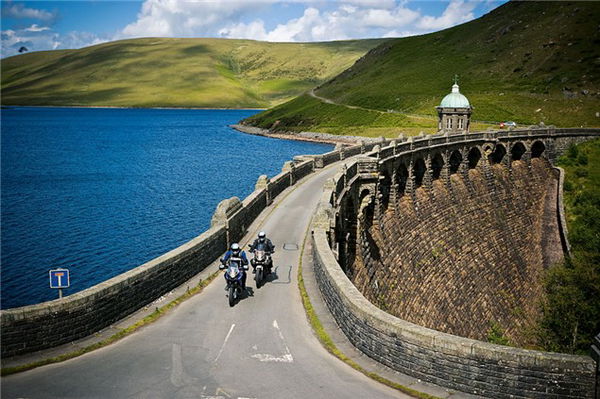
Everybody is talking about rocketing sales in the UK Adventure motorcycle sector, so much so that one company has even made a tent for them It’s true that some are styling exercises and incapable of traversing more than a series of puddles, but most are extremely practical and some even more fun than the sports bikes that they are hammering in the sales charts.
A giant Adventure bike is cheaper to buy, insure and maintain than a sports bike, and is less likely to go missing or lose you your licence. If you only ride at weekends on short-term, road-biased adrenaline blasts then nothing is going to prise the sportsbike from your cold, dead hands, but for those looking for something more from their riding, it’s hard to ignore adventure bikes.
All has not been perfect in Adventure Land, however. In the past several models have been aimed at bigger, more experienced riders - a BMW R1200GS Adventure with all the bells and whistles on is an intimidating tool for any rider, let alone a beginner. Indeed, there’s not been much in the way of introductory or middleweight contenders to add balance to the influx of global crusaders hitting the showroom floors. Until now. 2008 has seen the launch of three significant models, all of which have ancestry, pedigree, or both.
From gentle green-laners to the full Ranulph Fiennes, the F800, Transalp and Tenere can take you places you never even knew you wanted to go. Yamaha and Honda have given us fresh-faced upgrades of models that have been kicking around for 20 years while BMW have built a smaller, more manageable version of their legendary off-roader but with an all-new engine and – horrors! – a drive-chain instead of a shaft.
The new XT660Z Tenere has an enviable history of desert racing, fantastic styling and a mouth-watering price tag, while the XL700V Transalp has already secured its place as the unbreakable Steady Eddie of the mid-size ramblers. BMW have transplanted the power-plant from the unloved F800 road bike into a very interesting package that has the potential to open up the market.
The Welsh assembly forms in an M4 service station and I’m already eyeing the Transalp with suspicion as it stands out like a camp tart next to these macho off-roaders. I can’t quite figure out why they settled on the quirky styling that is neither one thing nor the other, though undeniably unattractive. Parked next to the Tenere, I also can’t decide whether the Honda looks too short or the Yamaha too tall until I swing a leg over it and realise that the seat is actually very low to the ground, which is no bad thing considering the lack of choice for ladies and lower gentlemen.
With the smallest of engine capacity increases (up 30cc to 680) the Honda sounds and feels very similar to its predecessor as it happily chugs onto the motorway and settles into a steady trot. Being sub six-foot is fine but anyone straying above that benchmark will feel and look a bit daft as they begin to dwarf the poor thing. Dimensions and styling aside, this is a Honda so everything is going to be just fine, because it always is. At a steady 80mph, the V-twin is quiet and smooth at just over 5,000rpm and extremely comfortable. I’d be genuinely happy, if unexcited, to spend day after day in this soothing saddle behind the surprisingly effective screen.
In contrast, the XT stands tall and proud, and as skinny as a supermodel with a very purposeful, funky appearance. I like its angles and desert Khaki colour scheme and bet that this is a proper off-road tool. As I swing a leg over it at the first changeover I smash my shin against the passenger grab-rail and climb aboard. Thanks. It dawns on me that it looks tall because it is, and even my lengthier travel companions struggle to mount the beast. Unless I’m mistaken, Yamaha have dropped a slight clanger with the 895mm seat height (it actually feels even higher than that) and we haven’t so much as fired it up yet. I’m short but not short on confidence so it won’t bother me in the slightest, but I pity the poor punters who visit their local Yamaha dealers only to find that they’re struggling to climb aboard.
To confirm my theory, I thumb the modestly powered single into life and shift through the gears to the 80mph/5,000rpm region and settle into a groove. After a short while, I take both feet off the pegs and attempt to scrape the toes of my boots on the tarmac and fail to make any contact. Other than potential traffic light howlers, another disadvantage of being so high up is that you’re more exposed to the elements and subject to a steady blast of air that travels up via the forks and yokes into the face. After the Honda, the seat feels firmer and the motor, being a single, is understandably less smooth, but we’re admittedly cruising at a speed that is slightly above the ideal for the Yam. I’m not worried as the XT looks like it will turn the tables once the we’re finished with the monotony of the M4.
Fancy heading west to Wales for the weekend?
If you ride a bike - any bike - and haven’t ridden to Wales for a two-wheeled break yet, then you’re just plain daft. Glorious roads, great scenery, and even the Welsh themselves aren’t overly scary, being entirely welcoming and hospitable in many places. We’d be lying if we said the food was top notch, though. It’s only two hours down the M4, bikes are free on the Severn Bridge toll, expect to pay around £50pp for a good hotel. For the best roads explore the triangle between Abergavenny, Llandovery and Builth Wells. If you want to do it on the rough there’s hundreds of campsites to choose from, and the off-roading is some of the best in the country. Go to www.visitwales.com
I already had a quick cross-country blast on the GS a few weeks ago and am pleased to report that sitting on it feels extremely normal, without a hint of controversy. The bug-eyed and beaky front end is very appealing yet the overall look is more approachable and usable than its bigger brother. Start up the parallel twin and a more satisfying engine note than you’d expect is emitted, but give the throttle a blip and the bark from the back end is near musical. It’s one of those bikes that will have even the most considerate motorcyclist blipping its tits off at every opportunity.
Having a 25bhp advantage over the Honda and weighing 30kgs less, the GS hits the cruising pace effortlessly and settles at much the same revs as the others. Overtaking at higher speeds is easier too and despite it being the only 6-speeder here, it is also the least likely to need a down-change in order to make a pass as the motor has far stronger midrange than expected. But BMW have made a rather stingy allowance for fuel with a tank capacity of only 16litres – not ideal for a bike that has a sweet engine that loves to be revved. Secondly, as if to confirm that you won’t be travelling too far between stops, the seat is just not comfortable. It’s a little narrow but basically too hard – a mistake KTM made with their original 950 Adventure. Perhaps the Germans are merely stressing the off-road bias for this intro model and are making us wait for their beefed-up Adventure version before we can truly consider global touring.
We’ve established that the Transalp is in a league of its own in terms of high-speed cruising and comfort, but is that all it has to offer? With the Bristol Channel behind us, and excellent tarmac ahead of our campsite destination in Rhayader, the low-slung Honda has the chance to keep its nose ahead of the rest. It’s fair to say that what the Transalp lacks in excitement, it replaces with sheer unstoppabilty. The SOHC V-twin is allowed 60bhp to haul 238kg plus rider so progress is always going to be sluggish, but the new, smaller 19” front wheel does combine nicely with the low centre of gravity to create fairly impressive turn-in and cornering ability. Pick up the pace and it won’t get upset, but you’ll need to keep the motor spinning between 6,000rpm and the 8,000rpm redline to maintain decent progress.
The peppy Tenere makes surprisingly light work of the twisty A-roads despite being at a power and weight disadvantage. Its exceptional fuel capacity of 22 litres does have a bearing on the handling as that’s a lot of kilos sitting up high, but it also has a very positive bearing on its range – I noticed at our first fuel stop after 140 miles (the GS was very low) that the XT’s gauge showed that it had half a tank left. That’s what I call a useful touring range. Other than having a top-heavy feel with a full tank, it means that the Yam will tip the scales at over 200kg after a re-fuel, so the sub fifty-brake engine does a good job of propelling the thing forward and keeping up with the Transalp. You have to work it hard, don’t ask it to pull from less than 2,000rpm (unless you like the sound of chain slap) and it’s essential to be in the right gear for overtaking, but the XT really is a lot of fun amongst these bigger bikes and not the chore that the spec sheets might suggest. It handles better than it should too. Despite the high weight and full size front wheel I’m beginning to take a proper shine to it, especially as the real fun stuff lies ahead.
Meanwhile, the BMW is showing the rest a clean pair of heels, and that’s with the full size panniers crammed with photographic gear. It seems to find enough pull to drive out of turns in whatever gear you find yourself in, and delivers an increasingly strong charge from 6,000rpm to the 8,500rpm redline. This 2,500rpm zone is a real sweet spot, and it takes some discipline to resist constant thrashing, such is the pleasure that it delivers. It’s not necessary to rev it, as it’ll pull cleanly from very little revs in every gear, it’s just a tad addictive. In fact, I can’t imagine how BMW could have done a better job of tuning this engine. It’s that bloody good. The beefy 45mm USD forks can handle all the braking and turning you throw at them, but with a lengthy 230mm of travel, there is always going to be a fair amount of dive to deal with before feeding that 21” wheel into the turns. It’ll turn in just as quickly as the Transalp though, despite its larger front wheel so no complaints there. The Bridgestone Battle Wing tyres fitted are the most road-biased here so no wonder that it felt so good flicking along the A470. Hooligans will appreciate the ease with which that very same wheel heads skywards with a simple snap of the throttle in first. There’s more to the GS than meets the eye it seems.
It’s always a pleasure to sample Welsh roads, until you realise how many trucks there are to spoil the fun. However, we’d had a half-decent run and pitched our tents before dark, whilst sober and without fighting. Hardly in keeping with tradition but a sensible novelty, and much appreciated by the local midges. We were sober because we couldn’t resist a taste of the trail; a few fast, unmade roads circuiting local reservoirs, the occasional water crossing and a nadgery trail or two should see us back in time for a few pints and a curry.
The Adventure sport category should be more clearly defined with two categories: those that can hit the trail, and those that are merely pretending. The Transalp is clearly a pretender so my expectations are low, and rightfully so as the Honda doesn’t impress. With so little ground clearance and a fake bash plate that exposes the sump, it wouldn’t be right to hammer it on the rough. In fact, if you tried you’d be on your arse in no time as anything more than a gentle stroll across a meadow will have the Honda lurching, as I discovered on a rough, stony track at 40mph. The Honda is 99% road bike and will, on identical rubber, probably go no further than its Deauville brother when you depart from the smooth stuff. Fair enough, it’s not trying to be anything else so we’ll leave it there. But not before one significant mention. The reason I didn’t end up on my arse is because the ABS system on the Honda is fantastic. I’m a fan of ABS (off-road only) because it works so well and has saved my bacon on numerous occasions over the years and this system is so smooth that it’s hard to tell when it’s kicking-in. More than you could say for the Beemer.
Time for the Tenere to shine then? This is precisely where the tall stance and huge ground clearance comes into play as it picks its way effortlessly through ruts and over obstacles that would have the Transalp in tears. A heavy boot will soon lock the rear wheel easily enough but it doesn’t take long to adjust to the lack of ABS. Weight the pegs and feed in the gas and the now nimble blighter will delight with precise power slides, and dart easily between corners. The lack of power is now an advantage as the capable Metzeler Tourance tyres manage to cope with a sudden handful of throttle and over zealous approaches. This is proper fun and not in the least fatiguing for the rider, while the feel from the standing position is the real off-road deal.
As with the Yamaha, the BMW, though fitted with tyres that favour tarmac, has the wheel dimensions to experiment with more serious rubber which I’d very much like to do. Regardless, it is just so impressive as standard. It seems perfectly balanced and has the grunt to cope with all situations, and sublime fuel injection and throttle response to boot. No hill too steep, no trail too tight. No need to worry about gear choice either, just steer with the throttle and power through anything that stands in your way. The GS is a class act and equips the rider with a level of confidence that even Urry could appreciate. Suspension and brakes are forgiving enough to allow really fast progress.
CONCLUSION
At the end of the day, we have three very different motorcycles suitable for riders with different needs. The XT, with the smallest engine, needs the tallest rider but has an infectious charm that makes up for its shortcomings. This is a genuine long-distance global adventurer, that will be reliable, cheap to buy and run, and easy to ride on the rough. If you can find one, it will make an excellent commuter, too. The Honda will belong to ladies, pensioners, despatch riders and will disappoint few of its owners. It won’t affect the pulse but will deliver you to your destination in comfort.
The GS is a bloody gem of a bike. It was the one bike that each rider had to be prised off, that had us gushing about its engine and exhaust note, twittering about the inevitable Adventure version and wondering whether BMW have created a whole new mid-size sector, or whether it’s so good that 1200 sales will suffer. To put it in perspective, I’m not a fan of either the 1200GS or smaller adventure bikes, but I’d say that this is the first BMW I’ve ridden that put a genuine big, fat grin on my face. More importantly, this is the first BMW that I’d seriously consider (despite the extra layout) spending my own hard earned cash on. The F800GS is a truly exceptional motorcycle, and one that’s certain to get more people onto bikes like this.
Specifications
HONDA XL700V TRANSALP - RATING 3/5
PRICE: £5,399
ENGINE: 680cc, liquid-cooled, 8-valve V-twin
POWER: 60bhp @ 7,750rpm
TORQUE: 48 ft/lb @ 5,000rpm
FRONT SUSPENSION: 41mm non-adj
REAR SUSPENSION: monoshock, preload adj
FRONT BRAKE: 256mm discs, three-piston calipers
REAR BRAKE: 240mm disc, single-piston caliper
DRY WEIGHT: 200kg
SEAT HEIGHT: 841mm
FUEL CAPACITY: 18 l
TOP SPEED: 122mph
COLOURS: blue/black, gold/black
YAMAHA XT660 TENERE - RATING 3/5
PRICE: £4,899
ENGINE: 660cc, liquid-cooled, 4-valve single
POWER: 48bhp @ 6,000rpm
TORQUE: 36 ft/lb @ 5,500rpm
FRONT SUSPENSION: 43mm adj. preload
REAR SUSPENSION: monoshock, adj. preload
FRONT BRAKE: 298mm discs, two-piston calipers
REAR BRAKE: 245mm disc, two-piston caliper
DRY WEIGHT: 183kg
SEAT HEIGHT: 895mm
FUEL CAPACITY: 22 l
TOP SPEED: 112mph
COLOURS: White/red, khaki, black
BMW F800GS - RATING 5/5
PRICE: £6,695
ENGINE: 798cc, liquid-cooled, 8-valve twin
POWER: 85bhp @ 7,500rpm
TORQUE: 61 ft/lb @ 5,750rpm
FRONT SUSPENSION: 45mm usd, non-adj
REAR SUSPENSION: monoshock, fully adj
FRONT BRAKE: 300mm discs, two-piston calipers
REAR BRAKE: 265mm disc, single-piston caliper
DRY WEIGHT: 185kg
SEAT HEIGHT: 880mm
FUEL CAPACITY: 16 l
TOP SPEED: 124mph
COLOURS: yellow/black, silver/black
